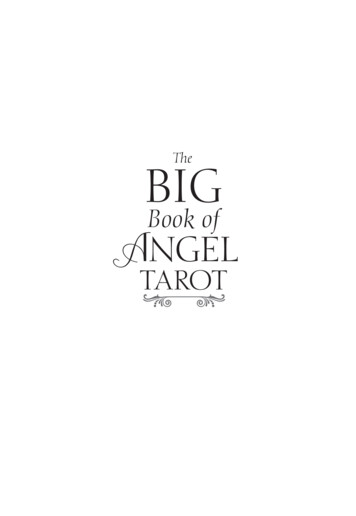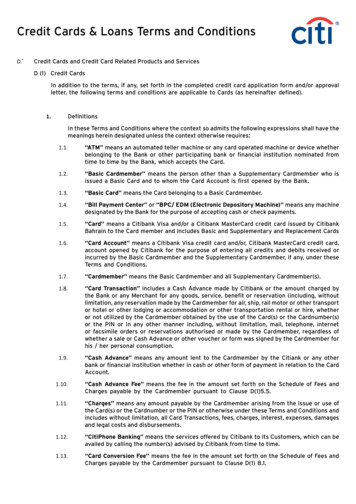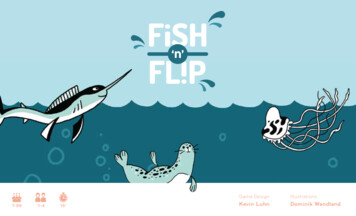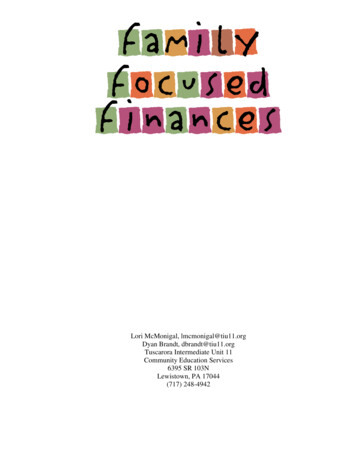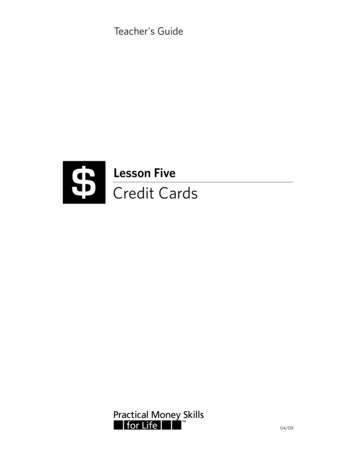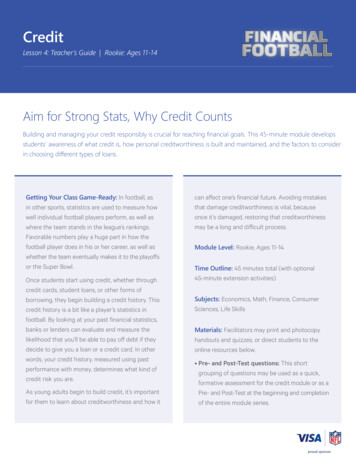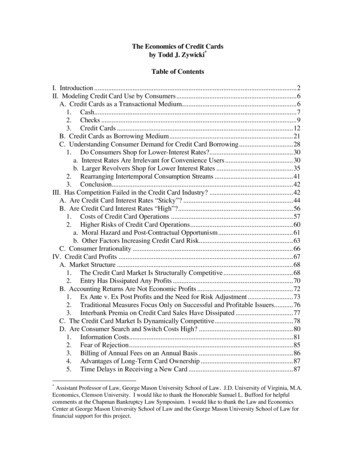
Transcription
The Economics of Credit Cardsby Todd J. Zywicki*Table of ContentsI. Introduction .2II. Modeling Credit Card Use by Consumers.6A. Credit Cards as a Transactional Medium.61. Cash.72. Checks .93. Credit Cards .12B. Credit Cards as Borrowing Medium.21C. Understanding Consumer Demand for Credit Card Borrowing.281. Do Consumers Shop for Lower-Interest Rates?.30a. Interest Rates Are Irrelevant for Convenience Users.30b. Larger Revolvers Shop for Lower Interest Rates .352. Rearranging Intertemporal Consumption Streams .413. Conclusion.42III. Has Competition Failed in the Credit Card Industry? .42A. Are Credit Card Interest Rates “Sticky”? .44B. Are Credit Card Interest Rates “High”?.561. Costs of Credit Card Operations .572. Higher Risks of Credit Card Operations.60a. Moral Hazard and Post-Contractual Opportunism.61b. Other Factors Increasing Credit Card Risk.63C. Consumer Irrationality .66IV. Credit Card Profits .67A. Market Structure .681. The Credit Card Market Is Structurally Competitive.682. Entry Has Dissipated Any Profits .70B. Accounting Returns Are Not Economic Profits .721. Ex Ante v. Ex Post Profits and the Need for Risk Adjustment .732. Traditional Measures Focus Only on Successful and Profitable Issuers.763. Interbank Premia on Credit Card Sales Have Dissipated .77C. The Credit Card Market Is Dynamically Competitive.78D. Are Consumer Search and Switch Costs High? .801. Information Costs.812. Fear of Rejection.853. Billing of Annual Fees on an Annual Basis .864. Advantages of Long-Term Card Ownership .875. Time Delays in Receiving a New Card .87*Assistant Professor of Law, George Mason University School of Law. J.D. University of Virginia, M.A.Economics, Clemson University. I would like to thank the Honorable Samuel L. Bufford for helpfulcomments at the Chapman Bankruptcy Law Symposium. I would like to thank the Law and EconomicsCenter at George Mason University School of Law and the George Mason University School of Law forfinancial support for this project.
6. Conclusion: Search and Switch Costs in the Credit Card Market Are Low andFalling .88E. Post-Mortem on the Failure of Competition in the Credit Card Industry and IssuerProfitability .89V. Usury Regulations and the Misunderstood Role of Marquette.90A. Was Marquette Irrelevant?.92B. A Short History of Usury Regulations .92C. The Problems of the pre-Marquette Regime.97D. Indirect Costs of Usury Regulations.103E. Empirical Analysis of Usury Regulations and the Case for Marquette .108F. Benefits of Marquette and the Deregulation of Credit Card Interest Rates .115VI. Some Tentative Bankruptcy Implications of the Economics of Credit Cards.117VII. Conclusion.124 S1I. Introduction @The skyrocketing bankruptcy filing rates of recent years are well known. Last yearover 1.3 million families filed for bankruptcy. Amazingly, that figure actually representeda slight drop from the previous year. Anxious to deflect blame from an overly generousbankruptcy system or a decline in the shame and stigma traditionally associated with filingbankruptcy, opponents of bankruptcy reform have fingered promiscuous lending practicesby credit card issuers as the primary culprit in the bankruptcy boom. 1 In particular, it ischarged that, spurred on by high profits, credit card issuers have extended increasingamounts of credit to ever-riskier borrowers. If this is so, then the credit card companieshave no one to blame but themselves when these borrowers default on their obligations,file for bankruptcy, and impose losses on lenders. For similar reasons, some bankruptcyjudges have frowned upon dischargeability objections by credit card issuers. Moreover, itis said to be the height of hypocrisy for these same credit card issuers to then turn aroundand demand tighter bankruptcy laws to bail them out of this problem of their own making.Finally, it is argued that because these losses simply come out of the “profits” of credit2
card issuers, bankruptcy simply results in a wealth transfer from lenders to borrowers andno resultant efficiency loss for other consumers.But this theory rests on a substantial number of questionable assumptions aboutnature of the credit card market and about the nature of rational credit card use byconsumers. It assumes a persistent failure of competition in the credit card market, despitethe existence of thousands of firms, low barriers to entry, and high levels of dynamiccompetition during the very period that high profits supposedly persisted. It furtherassumes a remarkable degree of consumer irrationality, requiring consumers tounderestimate their credit card bills – and only their credit card bills and none of theirother financial obligations – month after month and year after year. It requires assumingthat consumers never become more intelligent about their options, despite billions ofdollars spent by credit card companies to inform consumers of the different product optionsthat are available to them. It requires a belief that the sole indicium of competition in thismarket is the responsiveness of credit card interest rates despite the fact that only aminority of credit card users revolve balances from month to month. The thesis requiresassuming that credit card users are homogenously concerned only about interest rates andnot about any other term of the credit card contract, whether benefits, grace periods, orannual fees. In short, for the argument to be plausible, it requires a series of heroicassumptions about persistent profits in a market with low barriers to entry, a failure ofcompetition in a market with all structural indicia of competitiveness, a peculiar andextraordinarily narrow definition of the indicia for measuring competition, and a failure of1See Edith H. Jones & Todd J. Zywicki, It’s Time for Means-Testing, 1999 BYU L. REV. 177, 224-28(1999) [hereinafter Jones & Zywicki].3
consumer rationality in a situation where there are strong incentives for consumers to actrationally and to learn over time.Alternatively, it could be argued that the credit card market is competitive and thatconsumers use credit cards rationally. As this article will show, both credit card issuersand consumers appear to act in a manner consistent with the predictions of economictheory. It is not necessary to rely on implausible assumptions about consumer irrationalityor to devise idiosyncratic models of a failure of competition in the credit card market.This article will present voluminous empirical evidence – most of which has heretoforebeen ignored in the legal literature – demonstrating that the operation of the credit cardmarket and consumer choice is consistent with rational decision-making subject toconstraints. This article will show that credit card users are not homogenous indeed, itwill show that most credit card users will be largely indifferent to interest rates, and thatthis indifference is rational. Moreover, this suggests that there is some efficiency loss as aresult of bankruptcy, and that at least some of the losses of credit card issuers are absorbedby other consumers.As this paper will show, the analytical premises that underlie the purported linkbetween credit cards and bankruptcy are suspect. There are simply too many holes in thestory and too many implausible assumptions that undercut the proffered link. Because thesefactual predicates are necessary for the argument against credit cards to succeed, theirfailure brings the whole edifice of the purported credit cards—bankruptcy link down withit. Without an explanation for long-term, persistent economic profits there is no basis forassuming that credit card issuers will continue to expand credit to ever more riskyborrowers. Without an explanation for long-term, persistent consumer irrationality then the4
entire explanation for economic profits collapses. And, in fact, it turns out that thepurported link itself is bereft of empirical support. 2This is not to deny that there may be abuses in the credit card market, as with anylending market, that require further disclosure or other forms of substantive consumerprotection regulation. If so, then those proposals should be considered and dealt with ontheir merits. I offer no opinion on that issue here. But issues of abuse and inadequatedisclosure are separate from issues related to bankruptcy. Tying credit card regulation tobankruptcy reform confuses two distinct issues and risks simultaneously disfiguring bothbankruptcy law and credit card regulation. Bankruptcy is at the periphery, not the center,of the debate over credit cards.Finally, too many bankruptcy policy-makers and judges have been distracted by theerroneous model that dominates current discussion on the topic of credit cards andbankruptcy, leading to ill-advised legislative reform proposals and confused judicialdecision-making. If enacted, these policies will have little negative impact on the uppermiddle class academics, judges, and lawyers who propound them but who also can easilyescape their reach. On the other hand, these policies could have dramatic negativeconsequences for vulnerable low-income consumers who lack the borrowing options ofwealthier individuals and as a result may be driven back into the hands of pawnbrokers,rent-to-own financiers, and loan sharks who flourished prior to the deregulation of thecredit card market. A proper understanding of the economics of credit cards is necessaryfor a proper understanding of the root causes of the bankruptcy crisis.2See infra notes 263-92 and accompanying text (presenting brief discussion of the purported linkbetween credit cards and bankruptcy). A full critique of the purported link between credit cards andbankruptcy is presented in Todd J. Zywicki, Credit Cards and Bankruptcy (Aug. 28, 1999) (unpublished5
S1II. Modeling Credit Card Use by Consumers @Credit cards perform two functions.3 First, they may be used as a transactionalmedium, as a substitute for cash and checks. Second, they may be used as credit, as asubstitute for other forms of short-term, small-dollar value credit, such as layaway plans,pawn shops, and short-term bank loans. Bankruptcy commentators have largely focused onthe latter use, decrying the seemingly high interest rates of credit cards as a form of creditand using this as evidence of consumer irrationality and lender exploitation. Both thisfocus on credit cards primarily as a form of credit, and the conclusion that such use isirrational, are incorrect. S2A. Credit Cards as a Transactional Medium @The primary use of credit cards today is as a transactional medium, not as a sourceof credit. Over half and probably as much as 68% of credit card users should beconsidered “convenience users,” who use credit cards primarily as a transactional mediumand who pay off their balances in full each month. 4 Moreover, convenience use of creditmanuscript on file with author at George Mason University School of Law) [hereinafter Zywicki, CreditCards].3See Dagobert L. Brito & Peter R. Hartley, Consumer Rationality and Credit Cards, 103 J. P OL. ECON.400, 401 (1995).4See Thomas F. Cargill & Jeanne Wendel, Bank Credit Cards: Consumer Irrationality versus MarketForces, 30 J. CONSUMER AFF. 373, 379 (1996) [hereinafter Cargill & Wendel] (noting that 68% of users“nearly always” pay their full balance every month); Randall J. Pozdena, Solving the Mystery of HighCredit Card Rates, 42 FRBSF WEEKLY LETTER 1 (1991) (stating “over half” of card users do not revolvedebts); Delinquency on Consumer Loans: Hearing Before the House Comm. on Banking and Fin.Servs., 104th Cong. 1 (1996) [hereinafter Crone, Delinquency], (testimony of Kenneth Crone) (“[M]orethan half of the usage of bankcards is for ‘convenience’ use only, which is paid off immediately, withoutrevolving.”); Glenn B. Canner & James T. Fergus, The Economic Effects of Proposed Ceilings on CreditCard Interest Rates, 73 FED. RES. BULL. 1 (1987) [hereinafter Canner & Fergus]. “In 1983, as in 1977,about half of families that used bank or retail credit cards stated that they nearly always paid their bills infull each month . . . . Such consumers can be considered convenience users.” Id at 5; LEWIS MANDELL,THE CREDIT CARD INDUSTRY: A HISTORY 139 (1990) (noting that by the late 1980s the proportion of users6
cards is rising much faster than revolving use of credit cards, increasing 20% in one yearalone.5 According to a recent Visa study it is also estimated that “almost 60 percent oftotal bankcard volume generates no interest, up from roughly 50 percent six years ago.”6The high rate of convenience use of credit cards relative to revolving use reflectsthe attractiveness of credit cards as a transactional medium. This attractiveness stems fromtwo basic sources. First, credit cards enable individuals to minimize their cash balances,thereby allowing them to shift their assets into higher-return investments. Second, there hasbeen an explosion in consumer demand for credit card use, largely as the result of theconvenience of using credit cards as a mechanism for conducting transactions.In any given transaction, a consumer will have any number of options as to how topay for the purchase.7 Consumers will choose their transactional medium according to therelative costs and benefits of using one method over another. Three basic forms oftransactional media are available: cash, direct claims against a bank (checks or debitcards), or credit cards. The attractiveness of credit cards relative to these other mediaexplains the rise of credit cards as a dominant method of making transactions.1.CashA consumer can use cash. Obtaining and using cash to finance transactions has veryfew benefits in the modern era relative to the alternatives. There are also substantialwho paid in full each month was approximately 50%, a figure that had remained relatively constant since1970). But see Lawrence M. Ausubel, The Failure of Competition in the Credit Card Market, 81 AM.ECON. REV. 50, 71 (1991) [hereinafter Ausubel, Failure of Competition] (noting that three-quarters ofcredit card users revolve balances). However, this assertion is simply incorrect. For a discussion of thevarious errors that Ausubel committed in calculating this figure, see Cargill & Wendel, supra at 379-80.5See Crone, Delinquency, supra note 4, at 1 (ascribing the rise in convenience to use to a growth in thenumber of retailers accepting credit cards and the popularity of co-branded cards among consumers); seealso Pozdena, supra note 4 (noting that the use of credit cards as a payment device is growing at a rate ofabout 10% per year and the amount of credit card debt outstanding is growi ng at only 6% per year).6Crone, Delinquency, supra note 4, at 1.7
transaction costs associated with acquiring cash, most notably the requirement to actuallygo to the bank to withdraw it. Although this cost has declined with the spread of automaticteller machines (ATMs), withdrawals from the ATMs of other banks requires the paymentof a fee. Overall, the transaction costs of obtaining cash at the margin makes cashrelatively less attractive than alternatives that do not require this.Cash is also unattractive as a primary transactional medium in that it earns nointerest when it is in your wallet. Indeed, because of inflation, cash carried in your walletearns a negative rate of return.Cash also has limited utility for conducting many transactions. For instance, cashcannot be used to pay bills or make purchases through the mail. Other cash transactionsrequire the creation of a formal receipt to memorialize the transaction.Cash does have some benefits for some transactions. Cash provides anonymity,whereas checks and credit cards do not. It seems doubtful, however, that the desire foranonymity will be very high in many cases.Thus, it seems that cash will be the preferred purchasing mechanism only forextremely low-value transactions: lunch, a newspaper, or a cup of coffee. In those cases,cash provides a speedy way of effectuating a small transaction. One need not carry largecash balances to engage in these transactions and the speed and convenience of cash isdesirable. Even in 1976, before the rise of credit cards and electronic commerce, cash wasused primarily only for small transactions.8 Larger transactions at that time wereconducted by checks. Credit cards were in small use and “[d]ebit cards were essentially7See also DAVID S. EVANS & RICHARD L. SCHMALENSEE, THE ECONOMICS OF THE P AYMENT CARD INDUSTRY5-15 (1993) [hereinafter EVANS & SCHMALENSEE] (giving a similar discussion to that presented here).8See Kenneth E. Scott, Electronic Commerce Revisited, 51 STAN. L. REV. 1333, 1339 (1999).8
nonexistent.”9 Today, cash continues to be used primarily for small transactions and thus isnot really a very useful transactional medium for many transactions.10In recent years, credit cards have increasingly become an effective cash substitute.This is primarily the result of technological advancements that have increased credit cardprocessing speed.11 As a result, credit cards are now accepted in such places as fast foodrestaurants, coffee shops, parking garages, supermarkets, movie theaters, and taxi cabs.A recently evolved alternative to cash has been the spread of “debit cards.” Debitcards provide an electronic confirmation of sufficient funds at the time of the transaction.Until recently, debit cards were still rarely used, but now their use has started to rise.Somewhat surprisingly, however, debit cards appear to be a substitute for cash rather thanchecks, as their use has grown most in venues such as grocery stores and gas stations.12This development is probably the result of increased processing speed of new electronicprocessing mechanisms.2.ChecksChecks have traditionally served as the primary transactional mechanism for largerconsumer purchases. One suspects, however, that this primacy has been by default – therewere many transactions for which cash was simply not a viable alternative, and hencewere conducted by check. These include paying bills by mail and making larger purchasesfor which one did not want to carry cash balances on one’s person. Again, using 1976 as abenchmark, although 66% of transactions at that time were conducted by cash, over 90% of9Id.See Jonathan R. Macey & Geoffrey P. Miller, Nondeposit Deposits and the Future of BankRegulation, 91 MICH. L. REV. 237, 252 (1992) (noting that transactions that cannot be effectuated bycredit card “are usually either very small, in which case the consumer can settle accounts with case, orvery large, in which case the consumer can pay by means outside the banking system, such as by drawing acheck on a mutual fund”).109
dollar payments were carried out by checks.13 Because checks were a higher-transactioncost medium, they were used primarily for larger-value purchases that justified using thesehigher transaction-costs.The problem with checks, however, is that they are fundamentally in the nature of acredit transaction. 14 By writing a check, an individual is representing that she has sufficientfunds to cover the check when it is drawn. The merchant, however, has no way ofconfirming this fact at the time the check is written. Moreover, even if there are sufficientfunds at the time the check is written, there may not be sufficient funds at the time the checkgoes to the bank to be cleared. As a result, merchants suffer potentially large risks of nonpayment from the use of a check. Merchants can do little ex ante to reduce this risk.There also is little reason to believe that individual retail merchants are in the bestposition to monitor or bear the risk of non-payment of checks. Merchants have acomparative advantage in bearing the risk of quality defects with respect to some of thegoods they sell. However, it is doubtful that retailers have any comparative advantage inbearing the risk or monitoring that a consumer will fail to make good on a check that iswritten. They may have the ability to “spread” some of their losses onto other buyers, buteven this will be limited in a competitive market. Moreover, it is likely that these losseswill fall heavier on small businesses, which will have less ability to spread them overtheir lower sales volumes. Casual empiricism tends to support this, suggesting that smallmerchants are less likely than larger merchants to accept personal checks. It is difficult toimagine that they can really do much to ensure that funds sufficient to cover a check will11EVANS & SCHMALENSEE, supra note 7, at 86-87.See Scott, supra note 8, at 1339.13Id.1210
actually be available some days later when the check is drawn against the writer’s account.As a result, forcing merchants to bear this risk does not seem efficient in any way. Creditcards enable merchants to shift the risk of a bounced check and consumer default to alower-cost risk-bearer, a bank or financial institution, that can monitor such risks.15To minimize this risk, and to increase the reliability of the consumer’s promise topay, laws have established several deterrence schemes. In addition to giving the merchanta claim against the check-writer for damages, some states allow presentation of checkswithout sufficient funds to be the basis for criminal penalties. At the very least, banks andmerchants assess a penalty of 20 or more for bouncing a check. These penalties arenecessary because of the status of a check as essentially a credit transaction, where aconsumer is making a naked promise to pay for goods or services and the seller has noability to verify the credit-worthiness of the buyer with respect to that transaction.In recent years, checks have yielded to credit cards as a medium of exchange forlarger-value, especially retail, transactions. Thus, while cash and checks are still used inroughly 95% of all payment transactions, they constitute only 77% of the total dollar valueof transactions.16 “The greatest growth (in terms of dollar value) has come in credit cards,which doubled from ten to twenty percent of the total between 1975 and 1995, reducing theshare of checks accordingly. Cash held its own, and debit cards have made hardly adent.”17 This erosion is expected to continue in the future. By the year 2005 it is predictedthat only 29% of transactional dollar volume will be conducted by check, while credit cardvolume is expected to rise to 28%. Debit cards are expected to rise to 20% of volume and14See Notes of Committee on the Judiciary, Senate Rep. 95-989 (1978) (“Normally, a check is a credittransaction.”).15See EVANS & SCHMALENSEE, supra note 7, at vii.16See Scott, supra note 8, at 1339.11
direct electronic transfers to 11%. Cash transactions are also expected to fall to 12% ofvolume, as electronic cash-substitutes become more popular.Thus, while cash retains its appeal for small transactions, the reduction intransaction costs of using credit cards has caused them to supplant checks as a mechanismfor conducting larger and non-face-to-face transactions. Consistent with the predictions ofeconomic theory, it appears that rational consumers have consciously decreased their useof checks and increased their use of credit cards as the latter medium has become moreattractive as a means of financing current purchases.3.Credit CardsRecent decades have seen a massive expansion in the use of credit cards as atransactional medium. Some commentators have incorrectly ascribed this explosion to theefforts of deregulated card issuers to “push” credit cards on unsuspecting consumers. Thisargument lacks merit and will be discussed in some detail below.18 A more plausibleexplanation for the rise of credit cards as a transactional medium is their convenience andthe other benefits they offer.19 In particular, credit cards have increasingly supplantedchecks as the preferred medium for transactions traditionally conducted by check. Thus, itis likely that the explosion in consumer demand for credit cards is the result of rationalconsumer choice, rather than improper creditor action.Credit cards offer two transactional advantages over cash and checks. First, unlikecash and checks, credit cards make it unnecessary to maintain cash reserves sufficient at all17Id.See infra notes 231-65 and accompanying text.19See Jones & Zywicki, supra note 1, at 229 (“Theories whose validity depends on the assumption thatconsumers are stupid about their money ought to arouse suspicion. And, unsurprisingly, a more plausibleexplanation is available.”).1812
times to cover current expenditures.20 Second, credit cards offer several ancillary benefitsunavailable to cash and credit cards.Credit cards provide flexibility for consumers in matching their income andexpenditure streams by alleviating the need to maintain sufficient funds at all times to covercurrent expenditures. Rather than necessitating an ongoing maintenance of cash balances,credit cards necessitate holding only enough cash to cover a check to pay the credit cardbill once a month. It is only when that single check is presented for clearance that theconsumer must ensure that she has sufficient funds to honor the check.The simple convenience of being able to make a purchase today without having toworry about the exact amount of funds available makes credit cards a convenienttransactional medium. The convenience of credit cards is illustrated by an exampleprovided by Brito and Hartley. They estimate that if bank accounts are earning a realinterest rate of 4.2% annually (higher than most money market and passbook accountstoday), and credit card balances accrue interest at 19.6% annually (several points higherthan the prevailing norm today), and credit cards begin to accrue interest immediately whencharges are made (which is rarely the case because most cards do not charge interest untilafter the close of the credit cycle and the end of a subsequent grace period), credit cardswould still be predicted to be used to finance about 23% of consumer transactions.21 Assuggested, this number certainly understates the real-world percentage of transactionsrationally financed by credit cards, as it overstates the attractiveness of holding moneybalances, overstates the interest rate on credit cards, and unrealistically assumes that2021Brito & Hartley, supra note 3, at 401.Id. at 406.13
balances begin to accrue interest immediately. Adjusting for these assumptions, the largenumber of convenience users in the population should not be surprising.Credit cards also permit consumers to carry interest-free balances for almost twomonths, as the cardholder can carry the balance interest-free not only during the creditcycle, but even for a “grace period” of twenty or more days after the credit period ends.Transactional users can avoid all interest charges by paying off the balance at the end ofthe period.22 By contrast, the credit card issuer carries an open, zero-interest account forthis entire period.23Cash and checking accounts usually produce no or little interest; a
Credit Card Rates, 42 FRBSF WEEKLY LETTER 1 (1991) (stating "over half" of card users do not rev olve debts); Delinquency on Consumer Loans: Hearing Before the House Comm. on Banking and Fin. Servs., 104th Cong. 1 (1996) [hereinafter Crone, Delinquency], (testimony of Kenneth Crone) ("[M]ore



